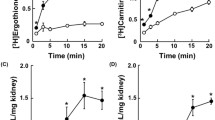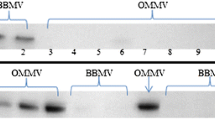Abstract
In order to study the specificity for the contraluminal sulfate transport system the inhibitory potency of disulfonates, di-, tricarboxylates and sulfocarboxylates on the35SO 2−4 influx from the interstitium into cortical tubular cells in situ has been determined. The following was found: 1) Methane- and ethane-disulfonate as well as benzene-1,3-disulfonate inhibit contraluminal35SO 2−4 influx (with an (app.K i of <6 mmol/l), while benzene-1,2- and 1,4-disulfonate do not. 2) The inhibitory potency of 1,3-benzene disulfonate is slightly augmented by an additional NH2 − or OH-group in position 4. However, OH-groups at position 4 and 5 or 4 and 6 abolish the inhibitory potency. 3) The naphthalene disulfonates tested inhibit only if they have an OH-group in ortho-position to one SO3H group. 4) The stilbene disulfonates H2DIDS and DNDS inhibit the contraluminal35SO 2−4 influx with high (app.K i≈0.8 mmol/l), DADS with lower potency (app.K i≈6 mmol/l). 5) Amongst the tested aliphatic di- and tricarboxylates inhibition was exerted by oxalate (app.K i 1.1 mmol/l) and maleate (app.K i 3.8 mmol/l), but not by malonate, hydroxymalonate and citrate. 6) Out of the tested benzenedicarboxylates only those inhibit which have the COO−-groups directly on the ring in 1,2 and 1,3 position (app.K i 4.0 and 2.7 mmol/l), but not in the 1,4 position. An additional OH-group in position 4 augments the inhibitory potency of 1,3 benzene-dicarboxylates (app.K i 0.8 mmol/l), while an OH group on position 5 abolishes it. 7) The benzene tricarboxylates (BTC) inhibit in the sequence 1,2,3-BTC>1,3,5-BTC>1,2,4-BTC (app.K i 0.9, 1.5 and 4.2 mmol/l, respectively). 8) The carboxy-benzene-sulfonates inhibit also in the 1,2 and 1,3 position only (app.K i 6.7 and 5 mmol/l), but not in the 1,4 position. Addition of an −OH-group to the 3-carboxy-1-benzene-sulfonate forming 4-hydroxy-3-carboxy-1-benzene-sulfate augments the inhibitory potency drastically (app.K i 0.32 mmol/l), while a NH2 substitution at the same position leaves it unchanged (app.K i 4.7 mmol/l). If, however, ethylamine instead of NH2 is used as substituent, the inhibitory potency is almost as high as of 4-hydroxy-3-carboxy-1-benzene-sulfonate (app.K i≈0.6 mmol/l). Amongst the dicarboxy-benzene-sulfonates, 3,4-carboxy-benzene-1-sulfonate inhibits (app.K i ca. 2 mmol/l), while 3,5-carboxy-benzene-1-sulfonate does not. The data indicate that a strong interaction of substrate with the sulfate transporter is given, when two charged groups (COO− and/or SO −3 ) are present in a distance equivalent to the meta-position on the benzene ring and an additional hydrogen bond forming OH- or −NH-group. Hydrogen bond forming groups and charged groups in other positions usually abolish the inhibitory potency.
Similar content being viewed by others
References
Barzilay M, Ship S, Cabantchik ZI (1979) Anion transport in red blood cells. I. Chemical properties of anion recognition sites as revealed by structure-activity relationships of aromatic sulfonic acids. Membr Biochem 2:227–254
Fritzsch G, Haase W, Rumrich G, Fasold H, Ullrich KJ (1984) A stopped flow capillary perfusion method to evaluate contraluminal transport parameters of methylsuccinate from interstitium into renal proximal tubular cells. Pflügers Arch 400:250:256
Fröhlich O (1982) The external anion binding site of the human erythrocyte anion transporter: DNDS binding and competition with chloride. J Membr Biol 65:111–123
Shami Y, Rothstein A, Knauf PA (1978) Identification of the Cl− transport site of human red blood cells by a kinetic analysis of the inhibitory effects of a chemical probe. Biochim Biophys Acta 508:357–363
Ullrich KJ, Rumrich G, Klöss S (1984) Secretion and contraluminal uptake of dicarboxylic acids in the proximal convolution of the rat kidney. Pflügers Arch 400:241–249
Ullrich KJ, Rumrich G, Klöss S (1984) Contraluminal sulfate transport in the proximal tubule of the rat kidney. I. Kinetics, effects of K+, Na+, Ca2+, H+ and anions. Pflügers Arch 402:264–271
Ullrich KJ, Rumrich G, Klöss S (1985) Contralumial sulfate transport in the proximal tubule of the rat kidney. II. Specificity: sulfate-ester, sulfonates and amino sulfonates. Pflügers Arch 404:293–299
Author information
Authors and Affiliations
Rights and permissions
About this article
Cite this article
Ullrich, K.J., Rumrich, G. & Klöss, S. Contraluminal sulfate transport in the proximal tubule of the rat kidney. Pflugers Arch. 404, 300–306 (1985). https://doi.org/10.1007/BF00585339
Received:
Accepted:
Issue Date:
DOI: https://doi.org/10.1007/BF00585339




